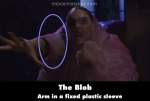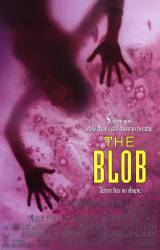Revealing mistake: In the last scene of the film where the Reverend is holding up the glass jar with the mini-blob in it, you can see the mechanism being used to move the blob (look between the Reverend's fingers). (01:30:30)

Revealing mistake: When the Blob is eating Paul at the doctors office, his right arm is the only part not covered. It's very obvious that it's in a fixed plastic sleeve surrounded by the Blob's ooze.
Revealing mistake: When Vicki is comatose while The Blob is inside her, you can see her blink despite her already being presumably dead.

Revealing mistake: The scene where Meg fights off the blob using a fire extinguisher isn't composited well. The blob and the street light are translucent. The street light even disappears when it's knocked down.






Answer: In both the the 50's original and 70s sequel, the majority of the Blob effects were created using a thick silicone gel colored with red vegetable dye; its movement was essentially controlled by gravity, just letting the goop run downhill and angling the camera to provide the illusion that it was moving horizontally, vertically, or straight at the audience. The original film also employed a large barrage balloon (or weather balloon) covered in the colored silicone goop for shots where people are actually consumed by the Blob. The 1972 sequel additionally used a preposterous rotating spit covered in red plastic, mounted in front of the camera, to provide the Blob's point-of-view as it steamrolled toward its victims. The 1988 remake used much more sophisticated practical effects such as robotics, latex prosthetics, pneumatic tentacles, et cetera, which were directly inspired by John Carpenter's 1982 special-effects-heavy horror flick, "The Thing." For the last couple of decades, there has also been talk of a major CGI reboot of "The Blob," but it has yet to materialize.
Charles Austin Miller